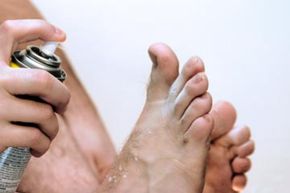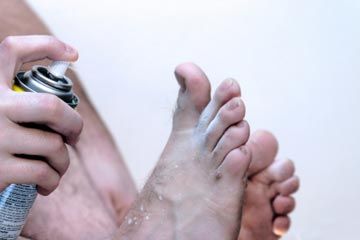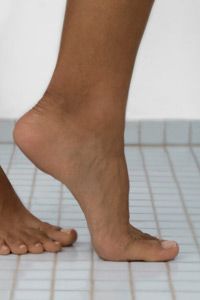It's the closest most of us will ever come to being an athlete. But aside from its familiar moniker, athlete's foot -- or tinea pedis -- really has nothing to do with sports. It's simply an infection caused by a fungus known as Trichophyton. That fungus lives on your skin but typically loses its ongoing battle with bacteria that also call your epidermis home.
A locker-room is the perfect atmosphere for Trichophyton to grow, but any hot, damp place will do -- and once athlete's foot takes hold, it can create dry, raw and highly itchy skin. The infection can even occur on the scalp, leading to hair loss, or in the groin area -- an unpleasant occurrence described as "jock itch." Fortunately there are many solutions to the problem.
Advertisement
- Stay dry. It seems counterintuitive to keep your feet dry when they're already itching and cracking, but it's dark and damp atmospheres that the fungus loves. Remove your shoes and socks whenever appropriate.
- Break out the iodine. If you have cracking in between your toes, then you may also have an infection involving bacteria. Put your feet in a mixture of iodine and warm water for about 20 minutes each day. Thoroughly dry your feet after soaking and then move on to the next step.
- Medicate. Commercials can promise a lot of things and fail to deliver, but over-the-counter remedies for athlete's foot are often quite effective. Creams tend to work best. Once your feet have been cleaned and dried, use medications such as undecylenic acid (Desenex), tolnaftate (Tinactin), or miconazole (Micatin). Twice a day should do the trick.
- Remember the shoes. It's like returning to the scene of the crime. Putting fungus-filled shoes on the feet you're trying to protect is asking for trouble. Kill off the fungus that's likely living in those shoes with powder, antifungal or antibacterial spray.
- Keep it at bay. Focus on prevention. Wash out your shower or bathtub with antiseptic after each use. If you shower in a locker room, wear flip-flops to minimize contact with the publicly used surface. Thoroughly dry your feet before slipping on a fresh pair of socks.
The vast majority of cases of athlete's foot can be treated at home if you're persistent. Don't assume the problem is gone because the symptoms have disappeared. Treatment needs to be continued for three to six weeks to completely remove the fungus. If you don't want to buy or use over-the-counter medications, consider soaking your feet in a mixture of water and vinegar each evening.
The ratio should be 1 cup (227 milliliters) of vinegar to 2 quarts (1.8 liters) of water. A 15- to 30-minute soak will do the trick. Saltwater can also be effective. Mix 1 teaspoon (4.9 milliliters) of salt per cup of warm water. Place your infected feet in the salty solution for 10 minutes, then dry. If your symptoms become worse or don't improve in one or two weeks, you may need professional care. Athlete's foot resulting in extreme cracking, oozing or pus can be an indication of a more severe condition requiring a doctor's attention.
Advertisement


